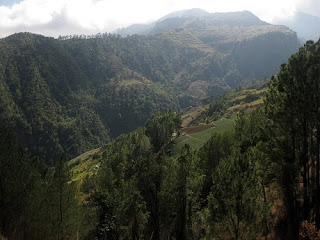 |
| Golden fields in the valley of Constanza |
The craggy peaks of the Cordillera Central cascade down into this
town, highest populated mountain valley in the Dominican Republic at 1,300
meters (4,264 feet) above sea level. Arriving in town on the back of a pickup
truck, descending on the winding road out of the hills and into the city, might
herald one of the best views in the country on public transportation.
Because of the chilly temperatures that drop as low as 5˚C (41˚F)
in the winter, local farmers are able to grow crops unusual for the island such
as roses, apples, garlic, and strawberries.
 |
| Greenhouse with tropical flowers for export |
Perfect for the outdoor enthusiast, Constanza boasts challenging
hikes, natural attractions, and adventure sports. The paths through the Ébano
Verde Scientific Reserve are cool and lush, often blanketed by thick fog in the
morning. On hot days in the valley, locals and visitors head to the tallest
waterfall in the Antilles, Aguas Blancas. Farther into the Cordillera Central
is the Valle Nuevo Scientific Reserve, perfect for pitching a tent and hiking
through the pine forests. Across the city of Constanza are relics of distinct
ethnic enclaves, once part of Trujillo’s campaign to both “whiten the race,”
and also introduce diverse agricultural techniques to the region. The four
enclaves include La Colonia Japonesa, Húngara, Kennedy, and Española. While the
Hungarians of Colonia Húngara and the Americans of Colonia Kennedy are long
gone, descendents of the Japanese and Spanish settlers still maintain strong
identities.
 |
| Farm to table is not just a fad, it's a way of life in Constanza.
|
Where to Eat
Aguas Blancas Restaurant
Aguas Blancas has a monopoly on Constanza-style gourmet, combining
local products to make exquisite dishes like cream of celery root soup or
guinea hen al vino for probably the
tastiest food in town. A must try are Doña Emilia Caceres’ inventive desserts,
such as the carrot or passion fruit flan. Behind the restaurant, there is a
small, plain hotel, in case delicious food must be within shouting distance.
RD$120-350; 10am-10pm; 54 C/ Rufino Espinoso; 539-1561
Esquisiteces Dilenia
 |
| Locals relaxing in park after the midday meal |
Specializing in oven-roasted lamb and dulce de fresa (strawberry
sweets), this restaurant is oozing with rustic charm from its exposed pine
walls to its cabin-inspired furniture and locally grown flowers adorning every
table. RD$200-360; 10am-10pm; 7 C/ Gaston F. Deligne, by Banco Popular;
539-2213
Where to Sleep
Alto Cerro
With options for all budgets, including luxurious villas, standard
hotel rooms, and camping spaces, this resort situated on the mountainside is
far enough from the center of town to enjoy the peace and fresh air of the high
mountain valley. Each villa feels like an alpine cabin, boasting a balcony to
enjoy one of the best views of the Constanza surroundings. On-site activities
and amenities include an exotic garden, fire pit, barbecues, zip line, soccer
field, basketball court, gym, spa, and horseback riding. US$20-43; 2km on
the highway to La Vega, across from the airport; 539-1553/1429;
reservas@altocerro.com; www.altocerro.com
What to Do
Aguas Blancas
 |
| View from top of Ébano Verde |
This cascading set of waterfalls is located at an altitude of
1680 meters (5512 feet) above sea level, is the highest in the Caribbean basin,
and according to the locals, the coldest on the island, with an average
temperature hovering at 10°C. The first section drops 53 meters (174 feet) in
height and the second, 38 meters (125 feet). Located near the small village
of El Convento, 14 kilometers on the road into Valle Nuevo
La Pirámide y el Monumento a Francisco Caamaño Deñó
Located in Parque Nacional Valle Nuevo, this tall stone structure
marks the geographical center of Hispaniola. Built by Trujillo, the pyramid is
the probably last thing the unsuspecting traveler would imagine in this remote
park.
 |
| Lichen at Ébano Verde |
On the other side of the highway is the monument to Francisco
Caamaño Deñó, hero of the 1965 uprising to defend the democratically elected
government of Juan Bosch.
Ébano Verde
A verdant scientific reserve with winding trails, Ébano Verde is
perfect for a daylong excursion. The reserve is home to over 80 species of
orchids and is blanketed by the brilliant green of ferns and lichen. There are
a number of bridges crossing small streams throughout the forest, which all
feed into El Arroyazo (“huge stream”) – providing a refreshing reward at the
end of the hike. Visits should be
arranged through Fundación Progressio (565-1422;
fund.progressio@codetel.net.do) or Constanza’s Tourism Office.














